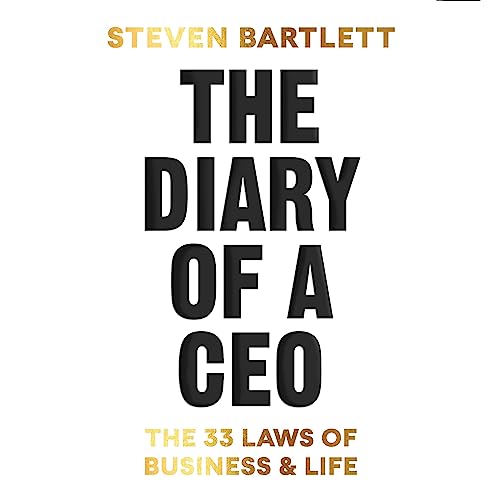I am always looking to expand my knowledge into new areas that can enhance how I approach marketing and business strategy. So I was intrigued when The Diary of a CEO by Steven Bartlett first landed on my radar.
Steven Bartlett is a young British entrepreneur who co-founded Social Chain and Media Chain, taking the company to $300+ million valuation before stepping down as CEO at age 27. Given Bartlett’s youth, I wondered how much insight he could impart compared to say, the business memoirs of an established Fortune 500 tycoon. But I have to admit that The Diary of a CEO wildly exceeded any expectations I had when I first cracked open the book.
Packed with savvy marketing psychology and personal development wisdom beyond Bartlett’s years, The Diary of a CEO offers thought-provoking perspectives that I believe any media or marketing professional could benefit from reading.
Rather than a standard memoir, the book reads somewhat like an episodic diary, interspersed with additional commentary expanding on business lessons and engaging in creative thought experiments.
Some chapters explore Bartlett’s personal backstory and the founding of Social Chain. But many feel reminiscent of a masterclass monologue. Bartlett plays wise mentor rather than simply recounting his rise to millions.
Top Takeaways from The Diary of a CEO
While the book spans advice on leadership, culture building, raising capital, and other topics, many of Bartlett’s sharpest insights connect to marketing, positioning and understanding consumer psychology.
Here were some of my favorite key lessons that media and marketing professionals can apply:
- “5 Buckets” Framework for Self Improvement
Early on Bartlett introduces a model for assessing and developing your professional capabilities consisting of 5 key “buckets”:
– Knowledge – What you know
– Skills – What you can do
– Network – Who you know
– Resources – What you have
– Reputation – What the world thinks of you
Regularly evaluating where you stand across those buckets helps reveal strengths to leverage vs. areas needing improvement – full first two “buckets” are important, this is foundation for the rest of “buckets”, but of course there are always exceptions. Useful mental model for identifying growth opportunities.
- Customer Service Recovery and Value Perception
Keep customers engaged during issues (e.g. play videos on Go3 platform while there are short platform issues) to retain loyalty despite problems.
- Innovating via “Psychological Moonshots”
Imagining innovations through a psychological lens (e.g. how can we use behavioral insights to create value) versus just a technical view. Better solutions come from understanding unmet needs. Case study of ideas for a TV – personalized ads based on viewer data, interactive shows via apps, rewards programs.

- Titles Matter – “Partnership” vs “Sales” Role Perception
Framing roles around shared goals rather than potentially adversarial dynamics changes perception. Ex. Rebranding sales team members as “partnership coordinators.” Helps attract talent interested in mutual benefit over pure persuasion.
- The “Goldilocks Effect” Pricing Strategy
Offering 3 pricing tiers – premium, middle, basic – makes the middle option appear as the “just right” sweet spot between extremes. Useful way to anchor consumers to mid-market offering as optimal value.
- Driving Conversions via Product Trials
Offering free trials, samples or limited period access dramatically increases subsequent purchase rates by letting consumers experience products firsthand. Reduces barriers relative to abstract marketing claims.
- “Kaizen” – The Power of Continual Small Improvements
Ongoing tiny optimizations compound over time into something far more impactful vs. periodic radical change attempts. Daily marginal gains through small tweaks beats yearly massive overhauls.
- “You Can’t Improve What You Don’t Measure”
Vital to closely monitor key performance indicators connected to goals. Without measurement, can’t track progress or spot dips indicating problems.
- Thomas Edison’s Wisdom on Perseverance
“I have not failed. I just found 10,000 ways that won’t work.” Before realizing game-changing inventions, Edison tried countless fruitless approaches. But each informed better solutions until hitting jackpot.
- Envisioning Failure Modes Via “Pre-Mortem” Analyses
Thoroughly gaming out hypothetical scenarios showing why a new idea or company would fail helps prepare contingency plans to prevent said failures. Stress testing for resilience.
- Don’t Let “Plan B” Undermine “Plan A”
Having backup options can sap motivation/effort from executing your primary plan. Avoid temptation to drift from priority goals.
- Conversations Shouldn’t Be Delayed Due to Discomfort
Hard talks around changes or conflicts often get postponed to avoid awkwardness. But issues then spiral, causing more pain. Lean into transparency early.
- Context Shapes Perceived Value
Bundling products/services together alters perceived worth relative to individual pricing. Ex. Adding support plan onto software. Combined cost seems lesser even if sums of parts equal same total.
- Time Allocation Determines Success
Obsession over maximizing value from each minute is a core theme. Calendar mastery lets you control health, relationships, influence. Time is limited.
- First 10 Employees Disproportionately Shape Culture
Who you hire early on will mold values and norms for those who follow as company scales. Critical to find talent aligned with founding principles.
- One “Bad Apple” Can Spoil the Bunch
While a single disgruntled employee leaving seldom ruins a company, one person allowed to remain despite misalignment with culture can influence many others to follow toxically. Cannot be tolerated.
Summary
As those highlights demonstrate, the diversity of business insights covered in The Diary of a CEO is impressive. It offers thought-provoking value for entrepreneurs and marketers alike.
I found Bartlett’s clear passion around customer-centricity and harnessing psychology to be particularly beneficial from a media perspective. His concepts for innovating experiences and engagement tactics provided sparks I can see directly inspiring new marketing campaign ideas.
Meanwhile, the leadership principles, culture building advice, and productivity tips offer helpful reinforcements that all organizations can stand to be reminded of periodically.
And the book manages to strike an enjoyable balance between conversational tone, structured frameworks, emotional vulnerability, and intellectual inspiration.
For media and marketing professionals, I highly recommend adding The Diary of a CEO your reading list. It will spur reflection around how you create value, communicate ideas, allocate time, optimize processes and put consumers first in refreshing ways.
This rising business icon clearly has much wisdom left to impart that belies his youth. And readers get to learn those lessons in an engaging, masterful modern memoir style. Don’t underestimate Bartlett or this book – both the man and The Diary of a CEO deliver the goods tenfold.
